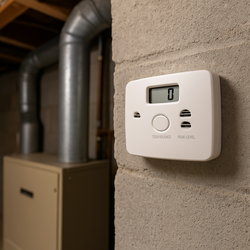Carbon Monoxide & Your Furnace: What Every Johnson County Homeowner Should Know
Every winter, as temperatures drop across Olathe and Johnson County, homeowners fire up their furnaces to stay warm. But few realize that one of the most dangerous risks inside their home is completely invisible — carbon monoxide (CO).
Carbon monoxide is called the silent killer for a reason: it’s odorless, colorless, and impossible to detect without proper equipment. When a furnace malfunctions or ventilation becomes blocked, CO can build up inside your home quickly — and the consequences can be deadly.
At Jack Harrison Heating & Air Conditioning, we take furnace safety seriously. Here’s what every Kansas homeowner should know about carbon monoxide and how to prevent it.
What Is Carbon Monoxide — and Why It’s So Dangerous
Carbon monoxide forms when fuel doesn’t burn completely. Furnaces, gas water heaters, fireplaces, and stoves all produce small amounts of CO — but when vented properly, it’s harmless.
The problem occurs when furnace components fail, exhaust vents become clogged, or the system isn’t maintained.
When CO builds up indoors, it replaces oxygen in the bloodstream, causing symptoms like:
Headaches or dizziness
Shortness of breath
Fatigue or nausea
Confusion or blurred vision
Severe exposure can lead to unconsciousness.
How Your Furnace Can Cause a Carbon Monoxide Leak
Furnaces are designed to keep you safe — but like any mechanical system, they need care and inspection to function properly.
Here are the most common furnace-related causes of CO leaks we find in Kansas homes:
Cracked Heat Exchanger – This is the #1 culprit. A small crack can allow exhaust gases, including carbon monoxide, to seep into your home’s airflow.
Blocked Flue or Vent Pipe – Birds’ nests, debris, or corrosion can block airflow, forcing exhaust back inside.
Dirty Burners – Improper combustion from clogged burners leads to incomplete fuel burning and excess CO.
Lack of Maintenance – Neglecting annual furnace tune-ups means small issues go undetected until it’s too late.
💡 Pro Tip: If your furnace is over 10 years old, schedule annual inspections to check for cracks, corrosion, and vent blockages.
How to Protect Your Family
Here’s what every Johnson County homeowner should do to stay safe this heating season:
✅ Install Carbon Monoxide Detectors
Place CO detectors:
Near bedrooms and on every level of your home.
At least 15 feet away from your furnace or fuel-burning appliances.
Test monthly and replace batteries twice a year.
✅ Schedule a Furnace Safety Inspection
A professional inspection ensures your system’s:
Heat exchanger is sealed and intact.
Venting is clear and properly connected.
Gas pressure, burner, and ignition systems are operating safely.
At Jack Harrison Heating & Air Conditioning, our technicians are trained to identify hidden safety issues before they become dangerous.
Signs You Might Have a Furnace Problem
If you notice any of the following, turn off your system and call for service immediately:
Furnace smells like burning or exhaust.
Soot buildup near furnace vents.
Family members experience headaches, nausea, or dizziness indoors.
Yellow or flickering furnace flame (should be steady blue).
Why Local Homeowners Trust Jack Harrison
As a family-owned business based in Olathe, we treat our customers like neighbors — because they are. Our team delivers:
Comprehensive inspectionsfor all furnace types.
Honest, affordable repairs with clear explanations.
Fast service when your comfort or safety is at risk.
We believe furnace safety isn’t optional — it’s essential.
Schedule Your Furnace Inspection Today
Before winter hits full force, make sure your home’s heating system is running safely and efficiently.
👉 Call (913) 308-3131 or schedule online to book your furnace inspection today.
Protect your family, your home, and your peace of mind this season.

